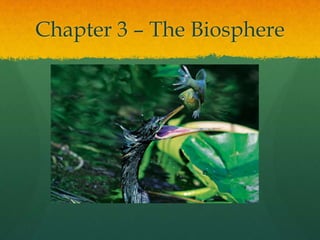Biology 1 Unit 3 notes
•Transferir como PPTX, PDF•
4 gostaram•2,631 visualizações
Denunciar
Compartilhar
Denunciar
Compartilhar

Recomendados
Recomendados
Mais conteúdo relacionado
Mais procurados
Mais procurados (20)
Trophic levels and energy variation with increasing trophic levels.food chain...

Trophic levels and energy variation with increasing trophic levels.food chain...
Semelhante a Biology 1 Unit 3 notes
Semelhante a Biology 1 Unit 3 notes (20)
20MNT31 & Environmental Science - Ecosystem (2023-24-II-AIDS-B).ppt

20MNT31 & Environmental Science - Ecosystem (2023-24-II-AIDS-B).ppt
Chapter 3 & 5 Lecture- Ecology & Population Growth

Chapter 3 & 5 Lecture- Ecology & Population Growth
Chapter 21 Ecology Lesson 2 - Pyramid of numbers biomass_carbon cycle

Chapter 21 Ecology Lesson 2 - Pyramid of numbers biomass_carbon cycle
Diploma. ii es unit 2.1 environment ecology and ecosystem

Diploma. ii es unit 2.1 environment ecology and ecosystem
B.tech. i es unit 2 environment ecology and ecosystem

B.tech. i es unit 2 environment ecology and ecosystem
B.tech. i es unit 2 environment ecology and ecosystem

B.tech. i es unit 2 environment ecology and ecosystem
Mais de petersbiology
Mais de petersbiology (20)
Último
Último (20)
Apidays Singapore 2024 - Building Digital Trust in a Digital Economy by Veron...

Apidays Singapore 2024 - Building Digital Trust in a Digital Economy by Veron...
08448380779 Call Girls In Greater Kailash - I Women Seeking Men

08448380779 Call Girls In Greater Kailash - I Women Seeking Men
Bajaj Allianz Life Insurance Company - Insurer Innovation Award 2024

Bajaj Allianz Life Insurance Company - Insurer Innovation Award 2024
Mastering MySQL Database Architecture: Deep Dive into MySQL Shell and MySQL R...

Mastering MySQL Database Architecture: Deep Dive into MySQL Shell and MySQL R...
Boost PC performance: How more available memory can improve productivity

Boost PC performance: How more available memory can improve productivity
What Are The Drone Anti-jamming Systems Technology?

What Are The Drone Anti-jamming Systems Technology?
08448380779 Call Girls In Friends Colony Women Seeking Men

08448380779 Call Girls In Friends Colony Women Seeking Men
08448380779 Call Girls In Diplomatic Enclave Women Seeking Men

08448380779 Call Girls In Diplomatic Enclave Women Seeking Men
The 7 Things I Know About Cyber Security After 25 Years | April 2024

The 7 Things I Know About Cyber Security After 25 Years | April 2024
From Event to Action: Accelerate Your Decision Making with Real-Time Automation

From Event to Action: Accelerate Your Decision Making with Real-Time Automation
[2024]Digital Global Overview Report 2024 Meltwater.pdf![[2024]Digital Global Overview Report 2024 Meltwater.pdf](data:image/gif;base64,R0lGODlhAQABAIAAAAAAAP///yH5BAEAAAAALAAAAAABAAEAAAIBRAA7)
![[2024]Digital Global Overview Report 2024 Meltwater.pdf](data:image/gif;base64,R0lGODlhAQABAIAAAAAAAP///yH5BAEAAAAALAAAAAABAAEAAAIBRAA7)
[2024]Digital Global Overview Report 2024 Meltwater.pdf
Biology 1 Unit 3 notes
- 1. Chapter 3 – The Biosphere
- 2. 3.1 Ecologists study environments at different levels of organization. Ecology is the study of the interactions among living things, and between living things and their surroundings.
- 4. Biotic and Abiotic Factors Biotic factors are any living part of an environment. plants animals fungi bacteria
- 5. Abiotic factors are any nonliving part of the environment. Sunlight Temperature Precipitation Humidity Wind
- 6. Biotic and Abiotic Factors Together Physical factors can be strongly influenced by the activities of organisms. Also, a change in physical factors can strongly affect the survival of the living organisms.
- 7. 3.2 Energy in Ecosystems Living organisms need energy for growth, reproduction, and their metabolic processes. Producers provide all of the available energy in an ecosystem Primary Productivity Producers are also called autotrophs because they make their own food. Most producers uses sunlight as an energy source.
- 9. Heterotrophs acquire energy from other organisms. Also called consumers
- 10. Consumers are not all alike. Herbivores eat plants. Carnivores eat other animals. Omnivores eat both plants and animals. Detritivores eat dead organic matter (detritus). Decomposers break down organic matter into simpler compounds. carnivore decomposer
- 11. 3.3 Energy Flow in Ecosystems A food chain links species by their feeding relationships. A food chain follows the connection between one producer and a single chain of consumers within an ecosystem. The ultimate source of energy for all producers and consumers is the sun.
- 12. Trophic Levels First Level – Producers Determine the available energy in the ecosystem Second Level – First Level Consumers AKA – primary consumers Herbivores Third Level – Second Level Consumers AKA – secondary consumers Omnivores and carnivores
- 13. Fourth Level Third level consumers (carnivores that eat other carnivores) AKA - top carnivores or tertiary consumers Decomposers – obtain energy from dead and decaying matter at all trophic levels. produce detritus Ex: bacteria and fungi decomposer
- 14. Energy Flow An energy pyramid shows the distribution of energy among trophic levels. Only 10 percent of the energy at each tier is transferred from one trophic level to the next. 90 percent of the energy is lost into the atmosphere as heat. energy transferred energy lost 100% 10% 1% 0.1%
- 15. Food Webs A food web shows a complex network of feeding relationships. An organism may have multiple feeding relationships in an ecosystem. A food web emphasizes complicated feeding relationships and energy flow in an ecosystem.
- 17. Pyramid of Biomass Biomass is usually measured in grams of organic matter per unit area. Why does the amount of biomass decrease moving up the trophic levels? tertiary consumers secondary consumers primary consumers producers 75 g/m2 150g/m2 675g/m2 2000g/m2producers 2000g/m2
- 18. 3.4 Cycles of Matter Elements essential for life cycle through ecosystems. A biogeochemical cycle is the movement of a particular chemical through the living and non- living parts of an ecosystem. Matter is recycled within and between ecosystems. Biogeochemical Cycles
- 19. Water Cycle
- 20. CarbonCycle
- 21. Nitrogen Cycle